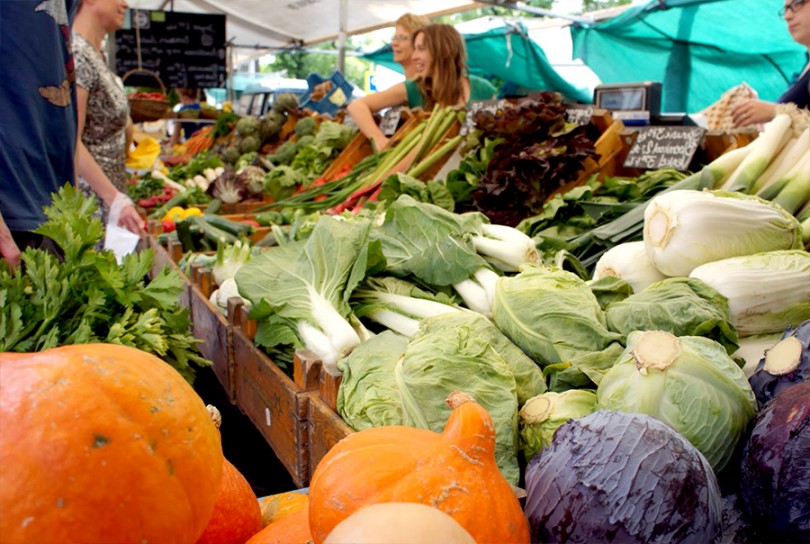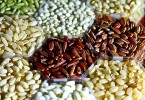A few years ago, “eating seasonally” for me meant sangria and salad on a quaint patio in the summer, and pints and meaty stews in a cozy pub come winter.
Times have certainly changed since then. Now “eating seasonally” means a sore back in the fall from shouldering canvas bags laden with butternut squash, pumpkins and beets from the local farmers market.
So why is it important to buy seasonal produce?
Because shopping seasonally goes hand-in-hand with shopping locally. Buying food at places like farmers markets can take your size 10 carbon footprint down to a size seven. (What is a carbon footprint? Click here to find out.)
If you live in a part of the country where there actually are seasons, most of those rows of shiny, happy (waxy) apples you see in large grocery stores had to be flown or driven in from another state or country. Driving and flying equals gas, which equals CO2 emissions, which equals a migraine for Mother Nature. Don’t get me wrong. It’s good that you’re eating apples in the fall — that’s when they’re in season — but it’s just as important to buy those apples from a local source. And there are many. Just ask the guy selling them at your local farmers market.
If you live in a part of the country where it’s always summer (and you can get your hands on avocados 24/7, every month of the year), you’re missing out on the importance of coordinating your diet with the natural cycle of the planet. And being able to buy watermelon in the winter isn’t necessarily a good thing. There’s a reason they only grow in the summer. Even the baked California earth knows it’s not normal to be popping out tomatoes in December. It’s not only about honoring the, like, seasons, man. It’s about feeding your body the foods the earth organically wants you to eat. Not to mention, do you really want to sink your teeth into that cool, fresh cantaloupe in November? Maybe a beet root salad drizzled with balsamic vinaigrette, followed by a baked sweet potato might taste better — and a bit more “right,” even.
And that’s another reason: taste. Seasonal food is fresher and therefore tastes better. Have you ever plucked a sun-ripened tomato from its vine mid-summer, popped it in your mouth and thought, “Wow, I’d much rather be eating one of those anemic tomatoes I saw in the grocery store last winter…*sigh*… ?” I doubt it.
Also, your local farming community will thank you for shopping seasonally. It’s always nice to support the local economy. There’s something satisfying about handing money directly to the person responsible for growing the artichokes I steamed and served with garlicky dipping sauce for dinner tonight.
What’s on the menu?

Fresh beets photographed by Amy McAloon
Here are a few examples of what’s ripe and good for eating in the fall:
- Beets
- Artichokes
- Sweet potatoes
- Cauliflower
- Brussels sprouts
- Apples
- Pumpkins
- Winter squash
- Pears
- Carrots
- Kale
- Pomegranate
Keep in mind that the list varies depending on your location and the season.Sustainable Table is a great reference guide for anyone wanting to find out more about seasonal food throughout the nation.
Making Babs proud
Last winter, I borrowed the book “Animal, Vegetable, Miracle” by Barbara Kingsolver from a friend, and realized the impact of my bad grocery shopping habits. The worst realization: My canned corn niblets came from Vietnam. Making the switch from grocery store to farmers market was effortless, and I am now able to sit and enjoy meals without feeling like I’m killing dolphins with every bite.
Here are a few tips for shopping at the farmers market:
- Research the season. Get online and find out what produce is in season so you are prepared and can plan meals around what’s available.
- BYO-bags. Theirs, if they even have them, typically suck. Get some sturdy canvas bags and preferably another set of arms to help carry the load.
- Don’t be shy. If you aren’t sure about how to prepare something, ask the vendor. Boiled beets, roasted beets, braised beets, pickled beets…
- Bring a camera. Turn your chore into an adventure, and snap some pictures of all the vibrant colours that make markets so beautiful.
- Most importantly, have fun. Grocery shopping no longer has to be about fluorescent lights and grouchy lineups. I know I certainly don’t miss my weekly outing to the nearest Big Box Store to buy corn. In the can. From Vietnam. Instead, I wait until it’s in season (that would be summer), skip the Super Store, and head out to the local farmers market with my canvas bags and a hankering for some fresh food. Like, say, spaghetti squash, which this time of year is fairly begging to be baked and scraped and smothered in butter and sugar. Go on, admit it — that sounds good, doesn’t it? “Right,” even.







